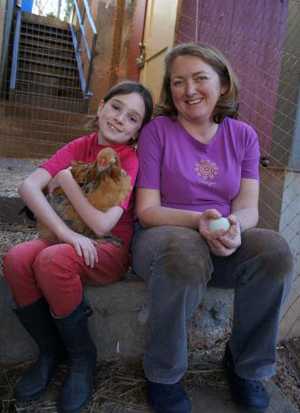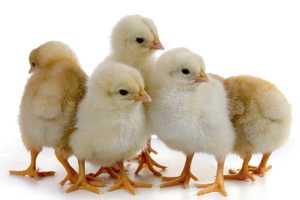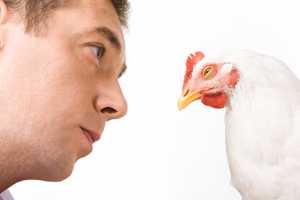Backyard Poultry

Chickens in the City
Meet Anne-Marie and Scarlett, mother and daughter who keep backyard poultry as a hobby.
Keeping backyard poultry (chicks, chickens, ducks, ducklings, geese, and turkeys) is becoming more and more popular. People enjoy raising baby chicks and having fresh eggs from their established flocks. Though keeping chickens can be fun and educational, poultry owners should be aware that chickens and other birds used for meat and eggs can carry germs that make people sick.
Germs from these birds can cause a variety of illnesses in people, ranging from minor skin infections to serious illnesses that can cause death. To protect yourself from getting sick, thoroughly wash your hands with running water and soap after contact with birds or their droppings. Although running water and soap are best, if you aren’t near a sink you can use alcohol-based hand sanitizer until you can get to a sink to wash your hands thoroughly.
Whether you are thinking about building your first chicken coop or are a seasoned backyard poultry farmer, you need to be aware of the risks of keeping poultry and learn about the simple things that can be done to help protect yourself and your family from illness. Click the tabs above for a list of diseases people can get from birds and information on how to keep yourself and your flock healthy.
Poultry includes any domesticated bird kept for producing eggs or meat, such as chickens, turkeys, ducks, and guinea fowl.
Common diseases that people can get from poultry include:
Bird flu, Avian influenza
Avian influenza is a virus carried by birds. Waterfowl, such as ducks, geese, and swans, do not always show signs of avian influenza infection, but poultry flocks can experience a range of illness, from decreased egg production to extremely high death rates.
No severe human illnesses caused by avian influenza have been reported in the United States. However, avian influenza has infected people in Africa, Asia, and Europe. In infected people, symptoms can range from conjunctivitis to severe respiratory distress, pneumonia, organ failure, and death.
Botulism, Limberneck (Clostridium botulinum)
Botulism is a rare but serious paralysis caused by a toxin produced by Clostridium botulinum, which is a bacterium found in contaminated food and environments. It also commonly lives in the gut of poultry and wild birds. Paralysis due to C. botulinum toxins is unusual in birds but does happen sometimes. Affected birds might have drooping eyelids; paralyzed wings, neck, or legs; and diarrhea.
Botulism in birds rarely affects people. Anyone who thinks they might have botulism should seek emergency medical care.
Campylobacteriosis (Campylobacter spp.)
Campylobacter is a type of bacteria that spreads to people through contaminated food (meat and eggs), water or touching stool of infected animals. It is difficult to predict the risk of Campylobacter from animals, because many animals, such as backyard poultry, can carry the bacteria without showing any signs of illness.
Most people who become ill with campylobacteriosis will have diarrhea, cramping, abdominal pain, and fever 2 to 5 days after exposure to Campylobacter. Campylobacter can cause serious life-threatening infections in infants, elderly persons, and those with weak immune systems.
E. coli (Escherichia coli O157:H7)
E. coli is a common type of food-borne bacteria that can also be spread to people by poultry and their environment. Backyard poultry affected by E. coli might not show any signs of disease or might die suddenly.
Symptoms in humans vary among individuals but often include severe stomach cramps, diarrhea (often bloody), and vomiting. Although E. coli infection rarely ends in death, blood in the urine is a sign of more severe disease that might be harming the kidneys.
Salmonellosis (Salmonella spp.)
Salmonella spreads to people through contaminated food (eggs and meat) or stool of certain animals, including backyard poultry. Live poultry might have Salmonella in their droppings and on their bodies (feathers, feet, and beaks), even when they appear healthy and clean. While it usually doesn't make the birds sick, Salmonella can cause serious illness when it is passed to people.
People exposed to Salmonella might have diarrhea, vomiting, fever, and abdominal cramps. Infants, the elderly, and those with weak immune systems are more likely than others to develop severe illness.
West Nile virus (WNV)
West Nile virus is carried by birds and spread by mosquitos. People, birds, and horses get WNV infection by being bitten by an infected mosquito. Although many birds, such as poultry, show no signs of infection, the virus can kill some bird, such as crows.
People infected with WNV can have a wide variety of symptoms, ranging from flu-like illness to seizures or more serious disease. WNV infection can be fatal in people.
Tips for preventing the spread of diseases from backyard poultry and waterfowl
In this section
CDC recommendations for keeping live poultry

Person washing their hands with soap and water.
-
Wash your hands thoroughly with soap and water
- right after handling birds’ food and water dishes or other equipment.
- after cleaning bird cages or perches.
- before you eat, drink, or smoke.
- Adults should supervise hand washing for children under 5 years of age.
- Use hand sanitizer if soap and water are not readily available. Be sure to have an alcohol-based hand sanitizer that contains at least 60% alcohol near the bird’s enclosure to encourage guests and children to clean their hands after handling birds.
- Don’t snuggle, kiss, or touch your mouth to live baby poultry.
- Do not let children younger than 5 years of age handle or touch chicks, ducklings, or other live poultry without supervision. Children younger than 5 years of age are more likely to get sick from exposure to germs like Salmonella.
- Don’t give live baby chicks and ducklings to young children as gifts. Because their immune systems are still developing, children are more susceptible to infection from germs commonly associated with live baby poultry, such as Salmonella, Campylobacter, and E. coli.
- Make sure that your children and anyone who is visiting your home follow these rules as well.
Preparing for your backyard poultry

Group of baby chicks.
- Check your state, local, and property laws before selecting or buying baby chicks, adult poultry (hens, roosters), or waterfowl. Many cities have rules against owning roosters because they violate noise ordinances with their loud crowing.
- Find out if there is a local veterinarian who has experience with poultry to help you keep your birds healthy.
- Learn what types of birds are suitable for your family. Certain types of birds, like young chicks, ducklings, goslings, and poults, might not be suitable for young children or people with weak immune systems who are living in the household.
- Research and learn how to properly care for your birds before you buy them. Ask your veterinarian about the proper food, care, and enclosure or environment that is best for the birds you are selecting.
- Build an enclosure. Backyard poultry need a sturdy environment that is easy to clean and that will protect them from wild animals and provide shelter from the weather.
- Be aware that birds can shed Salmonella, Campylobacter, E. coli, and other germs in their droppings. Plan to wear gloves when cleaning bird cages and poultry houses, and wash your hands thoroughly with soap and water after you have any contact with the birds or their environment.
Importing poultry into the United States
- USDA regulates the importation of poultry and poultry hatching eggs. Because avian influenza can cause serious illness, USDA restricts the importation of poultry and poultry hatching eggs from countries where avian influenza has been reported. People interested in importing poultry or poultry hatching eggs should visit the USDA Live Animal Importation website.
Choosing and introducing birds
- Pick birds that are bright, alert, and active. Birds should have smooth, sleek, and soft feathers that are free of debris or droppings. Birds who seem depressed, aren’t moving around very much or look dirty may be ill.
- When bringing new birds to an existing flock. be sure to keep them separated for at least 30 days before they are introduced. This will help prevent the new birds from passing disease to your flock. Make sure to clean and disinfect yourself when working between the two groups of birds during this period of separation. For example, you can wear a separate pair of gloves and boots, and you should wash your hands or at least use alcohol-based hand sanitizer when you go between the two groups.
- Contact your veterinarian if you notice any signs of illness in your poultry. Sick birds can:
- Be less active than normal.
- Eat or drink less than normal.
- Have ruffled feathers, discharge from the eyes or nose, difficulty breathing, or runny diarrhea.
- Produce fewer eggs than normal.
- Die unexpectedly of no apparent cause.
Housing backyard poultry

A woman stands near her chicken coop.
- Do not allow poultry or waterfowl inside your home.
- Provide your backyard poultry with a safe, sturdy environment outdoors, with housing areas and feeders/waterers that can be easily cleaned and disinfected.
- Do not house live baby poultry in areas where food or drink is prepared, served, or stored, such as kitchens or outdoor patios. Housing poultry in bathrooms is not a good idea either, but if you must keep them in bathrooms, be sure to clean and disinfect bathrooms with bleach or other disinfectant [PDF – 20 pages]. When using disinfectants, make sure to follow the label instructions for diluting the disinfectant and for leaving it on surfaces for the proper contact time before wiping or rinsing it off.
- Clean poultry enclosures and outside bird cages with a bottle of dish soap and a commercial disinfectant dedicated to this purpose. Go outside to clean any equipment or materials associated with raising or caring for live poultry, such as cages or feed or water containers. Do not clean these items inside the house. This could bring harmful germs into your home.
- First remove debris (manure, egg droppings, dirt) by wiping the equipment with warm water and dish soap to loosen the material.
- Once most of the debris is removed and the surface is generally clean, then apply the disinfectant, diluted properly according to label directions. Most disinfectants only work on clean surfaces and don’t work if they are applied directly to a dirty surface.
- Leave the disinfectant on the surface for the proper contact time listed on the disinfectant label, then rinse and allow the surface to dry before reuse.
- If possible, set aside a pair of shoes to wear while taking care of poultry and keep those shoes outside of the house.
Monitor your pet’s health

A veterinarian looks closely at a chicken for signs of illness.
- Work closely with a veterinarian who has experience with poultry for routine evaluation and care to keep your flock healthy and prevent infectious diseases.
- Keep coops and enclosures clean to prevent the build-up of animal droppings. When you clean droppings and cages, use disposable gloves, do not pick up droppings with your bare hands, and make sure to wash your hands thoroughly afterwards.
- If your birds become sick or die soon after purchase, inform the feed store or hatchery about the bird’s illness or death. Consider waiting before purchasing or adopting another animal. Do not reuse the cage or enclosure until it has been properly cleaned and disinfected.
- A healthy bird can still spread germs to people and other animals. If you become sick shortly after buying or adopting a bird, tell your health care provider about your new animal and other animals that live in your household.
Bird bites and scratches
Backyard poultry and waterfowl do not have teeth, but their bills and beaks can still cause a lot of damage if they bite or try to bite you. Germs can spread from bird bites and scratches, even when the wound does not seem deep or serious.
- Avoid bites and scratches from your backyard poultry or waterfowl. This will prevent injury and reduce the risk of your birds spreading germs to you.
- If you are bitten or scratched by a bird, you should:
- Wash wounds thoroughly with soap and water immediately — hand sanitizer is not as effective at removing germs as washing your hands with soap and water.
- Seek medical attention:
- if the bird appears sick.
- if the wound is serious (uncontrolled bleeding, loss of function, extreme pain, or deep wound with the muscle or bone exposed).
- if the wound becomes red, painful, warm, or swollen.
- if it has been more than 5 years since your last tetanus shot.
- If you seek medical attention, make sure to tell your doctor if you were bitten or scratched by a bird.
Feature stories
Risk of human Salmonella infections from live baby poultry
CDC feature
Thinking About Keeping Live Poultry?
CDC Public Health Matters Blog, October 5, 2010
Brochures/posters
Reducing your risk of a Salmonella infection from contact with live baby poultry [PDF – 1 page]
CDC
Spanish version [PDF – 1 page]
Podcasts
Why Parents Should Think Twice Before Giving Baby Birds to Young Children for Easter
CDC
Poultry-associated outbreaks
Investigation of a Multistate Outbreak of Human Salmonella Altona and Salmonella Johannesburg Infections Linked to Chicks and Ducklings
CDC Salmonella site
Multistate Outbreaks of Salmonella Infections Associated with Live Poultry – United States, 2007
CDC Morbidity and Mortality Weekly Report. January 23, 2009 / 58(02);25-89.
Three Outbreaks of Salmonellosis Associated with Baby Poultry from Three Hatcheries – United States, 2006
CDC Morbidity and Mortality Weekly Report. March 30, 2007 / 56(12);273-276.
Salmonellosis Associated with Chicks and Ducklings – Michigan and Missouri, Spring 1999 [PDF – 20 pages]
CDC Morbidity and Mortality Weekly Report. April 14, 2000 / 49(14);297-298.
Salmonella Serotype Montevideo Infections Associated with chicks – Idaho, Washington, and Oregon, Spring 1995 and 1996
CDC Morbidity and Mortality Weekly Report. March 21, 1997 / 46(11);237-239.
Beyer RS. West Nile Virus and Chickens [PDF – 2 pages] . Kansas State University, February 2003.
Guidance on using live poultry in classrooms or farm exhibits
Compendium of Measures to Prevent Disease Associated with Animals in Public Settings, 2011
National Association of State Public Health Veterinarians, Inc. (NASPHV). CDC Morbidity and Mortality Weekly Report. Recommendations and Reports. May 6, 2011 / 60(RR04);1-24.
Research articles
Ewers C, Antão EM, Diehl I, Philipp HC, Wieler LH. Intestine and environment of the chick as reservoirs for extraintestinal pathogenic Escherichia coli strains with zoonotic potential. Applied and Environmental Microbiology. Jan 2009: 75 (1), 184-92.
Poultry and poultry hatching egg import information
Animal and Animal Product Import Information
United States Department of Agriculture, Animal and Plant Health Inspection Service (USDA/APHIS)
Procedures for Importing Live Poultry
United States Department of Agriculture, Animal and Plant Health Inspection Service (USDA/APHIS)
Procedures for Importing Poultry Hatching Eggs into the United States
United States Department of Agriculture, Animal and Plant Health Inspection Service (USDA/APHIS)
Additional information
Backyard Poultry Biosecurity Practices to Keep Your Birds Healthy
United States Department of Agriculture, Animal and Plant Health Inspection Service (USDA/APHIS)
Healthy Flocks in Upcoming Seasons: Learn from the Experts [WMV]
Twitter Chat, August 19, 2014
Chat transcript
Antimicrobial Products Registered for Use Against Influenza A Virus on Hard Surfaces. [PDF – 20 pages]
List of approved Avian influenza disinfectants. Office of Pesticide Programs, Antimicrobials Division, U.S. Environmental Protection Agency (EPA)
National Poultry Improvement Plan
U.S. Poultry & Egg Association
- Page last reviewed: April 30, 2014
- Page last updated: August 28, 2017
- Content source:


 ShareCompartir
ShareCompartir